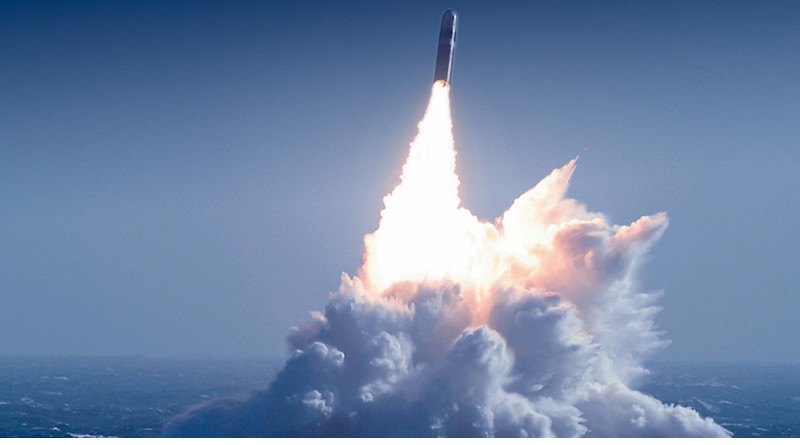Congress and the executive branch have debated the merits of a new nuclear-armed sea-launched cruise missile (SLCM-N) since the weapon was proposed by the first Trump Administration in 2018.
The Biden Administration proposed cancelling the SLCM-N program following its 2022 Nuclear Posture Review (NPR), a periodic assessment of U.S. nuclear policy. Congress has provided funding for the SLCM-N and its warhead; the FY2024 National Defense Authorization Act (NDAA) required the executive branch to ensure SLCM-N initial operational capability (IOC). Since the FY2024 NDAA, the U.S. Navy has taken steps to implement the SLCM-N program.
The Navy first deployed a nuclear-armed sea-launched cruise missile in the mid-1980s, when it placed the TLAM-N — a nuclear-armed version of the Tomahawk land-attack cruise missile — on surface ships and attack submarines. With a range of 2,500 kilometers (about 1,550 miles), the missiles were not included in the limits of U.S.-Soviet arms control agreements.
In 1991, at the end of the Cold War, President George H.W. Bush announced that the United States would withdraw all land-based tactical nuclear weapons (those that could travel less than 300 miles) from overseas bases and all sea-based tactical nuclear weapons from surface ships, submarines, and naval aircraft. The Navy withdrew the TLAM-N missiles by mid-1992 and eliminated the nuclear mission for U.S. surface ships, but retained the option to return the TLAM-N to attack submarines. Some observers characterized this redeployment ability as demonstrating the credibility of U.S. defense commitments to allies in Asia.
In 2010, the Obama Administration recommended that the Navy retire the TLAM-N missiles. The 2010 NPR stated that “this system serves a redundant purpose,” as it was one of several weapons the United States could deploy in support of U.S. allies. The Navy completed the retirement of these missiles in 2013.
The first Trump Administration reversed this decision, arguing in the 2018 NPR that a nuclear-armed sea-launched cruise missile (now known as SLCM-N) would provide the United States with a “non-strategic regional presence” that would address the “need for flexible and low-yield options.” SLCM-N was one of two systems that the 2018 NPR characterized as “modest supplements” that would “strengthen deterrence” of regional adversaries and assure U.S. allies.
The other 2018 NPR-recommended system was a low-yield version of the W76 nuclear warhead (known as the W76-2) for the Trident D5 long-range submarine-launched ballistic missile (SLBM). The 2018 NPR stated that the W76-2 was an option for the “near-term,” while SLCM-N would be an option implemented over “the longer term.” The Department of Defense (DOD) announced the deployment of the W76-2 in 2020. The Navy conducted an Analysis of Alternatives on the SLCM-N.
In its FY2022 budget request, the Biden Administration sought $5.2 million for DOD research and development work on the SLCM-N. It also requested $10 million for the National Nuclear Security Administration (NNSA) to study adapting the W80-4 nuclear warhead, intended for the Long-Range Standoff Weapon (LRSO) air-launched cruise missile, for delivery carried by the SLCM-N. Later, in the 2022 NPR, the Biden Administration proposed cancelling the SLCM-N, arguing that the missile was “no longer necessary” because of the W76-2 SLBM’s “deterrence contribution.” The Navy’s FY2023 budget request eliminated funding for the SLCM-N, stating that it was “cost prohibitive and the acquisition schedule would have delivered capability late to need.”
The Biden Administration did not include the SLCM-N in its FY2023, FY2024, or FY2025 budget requests. The Administration’s policy statements on the FY2023 and FY2024 NDAAs asserted that continuing the SLCM-N program “would divert resources and focus from higher modernization priorities.” Despite the Administration’s objections, Congress has provided continued funding for the missile and the associated warhead (see Table 1).
Table 1. Funding for SLCM-N ($ in millions)
Section 1640 of the FY2024 NDAA (P.L. 118-31) directed DOD to establish a “major defense acquisition program” for SLCM-N under the Under Secretary of Defense for Acquisition and Sustainment (USD A&S), initiate a program to alter the W80-4 warhead for delivery via SLCM-N, and “ensure” that the system achieves IOC no later than September 30, 2034.
Then-USD A&S William LaPlante testified in April 2024 that in March 2024 he directed the “Navy to establish a [SLCM-N] program office and to begin the analysis phase.” He also stated that the Nuclear Weapons Council, a joint DOD-NNSA coordination group, was “leading a review of options to execute the SLCM-N program in a manner that balances cost, deterrence value, and risk to the [nuclear modernization] program of record and the Joint Force.”
Section 1627 of the FY2025 NDAA (P.L. 118-159) provided DOD and NNSA with flexibility to select an alternative warhead for the SLCM-N; directed the Secretary of the Navy to establish a “separate, dedicated program element” for SLCM-N development in the FY2026 budget request; and limited certain funding unless the Secretary of the Navy certifies the establishment of a program office.
Vice Admiral Johnny Wolfe, Director of the Navy’s Strategic Systems Programs (SSP), testified in a May 2025 hearing that SSP was working to understand the challenges of developing and integrating the SLCM-N onto the Virginia-Class submarine. A May 2025 NNSA document stated that NNSA plans to use the “W80 warhead family” for the SLCM-N warhead. In August 2025, SSP and Naval Surface Warfare Center (NSWC), Crane Division, issued awards for the development of SLCM-N prototype designs.
The second Trump Administration did not request discretionary funding for SLCM-N (program element 0105519N) in the FY2026 Navy budget, assuming $1.92 billion in mandatory funding from FY2025 reconciliation legislation (P.L. 119-21), commonly referred to as the One Big Beautiful Bill Act. The FY2026 NNSA request assumed $272 million for the warhead. The FY2025 reconciliation legislation included $2 billion for DOD to accelerate work on the missile and $400 million for NNSA to accelerate work on the warhead.
The Senate Armed Services Committee-reported FY2026 NDAA (§1517 of S. 2296) proposes to authorize the DOD to use middle-tier rapid prototyping authority, to advance the IOC from 2034 to 2032, and to fund the missile at $320 million and the warhead at $186 million. The House Armed Services Committee-reported FY2026 NDAA (H.R. 3838) proposes to fund the missile and the warhead at $100 million each.
A key issue in the SLCM-N debate is whether adding the missile to U.S. nuclear forces is necessary to credibly deter limited nuclear use by adversaries and assure allies in Europe and the Asia-Pacific that the United States would protect them from nuclear coercion. The Biden Administration stated in 2023 that the United States has the ability in its “current and planned capabilities for deterring an adversary’s limited nuclear use through conventional and nuclear armaments,” including the W76-2 SLBM and air-delivered weapons such as the “Air-launched Cruise Missile, its successor… [the LRSO], and F-35A dual-capable aircraft that can be equipped with B61-12 nuclear gravity bombs.” (See CRS In Focus IF12735, U.S. Extended Deterrence and Regional Nuclear Capabilities.)
SLCM-N proponents have argued that SLCM-N’s attributes are different from low-yield capabilities delivered by other means. They say that aircraft that deliver weapons would need to either be “generated” (fueled, weapons-loaded, and flown) from the United States, which takes time, or else placed in regional bases, where they could be vulnerable to adversary strikes. SLCM-N proponents also argue that deploying the missile on surface vessels or attack submarines provides advantages, such as greater availability and regional presence, over deploying the W76-2 SLBM on ballistic missile submarines.
STRATCOM Commander General Anthony Cotton reportedly wrote in 2023 that “a low-yield, non-ballistic nuclear capability to deter, assure and respond without visible generation” could provide the President with additional signaling and response options in a crisis. In April 2022 testimony, General Mark Milley, then-Chairman of the Joint Chiefs of Staff, also expressed support for the SLCM-N. The 2023 final consensus report of the Congressional Commission on the Strategic Posture of the United States did not explicitly endorse the SLCM-N, but called for a prompt system that is “forward deployed or deployable”; “survivable against preemptive attack without force generation day-to-day”; possesses “a range of explosive yield options, including low yield”; and is able to penetrate adversary integrated air and missile defenses.
Observers have debated whether a U.S. nuclear posture that includes low-yield capabilities like the SLCM-N and the W76-2 and demonstrates a willingness to use nuclear weapons improves deterrence and allied assurance or increases the risk of nuclear war.
Policymakers have debated the potential role of SLCM-N in arms control. The 2018 NPR linked the missile to U.S. concerns about a new missile that Russia has deployed in violation of the 1987 Intermediate-Range Nuclear Forces (INF) Treaty. Although the United States withdrew from the treaty in 2018, the 2018 NPR stated that SLCM-N could provide a treaty-compliant U.S. response to Russia’s violation and incentivize Russia to engage in arms control on nonstrategic nuclear weapons. In contrast, the 2022 NPR argued that there is “uncertainty regarding whether SLCM-N on its own would provide leverage” in such negotiations. Russia has rejected negotiations concerning its nonstrategic nuclear weapons, citing these capabilities as necessary to offset to U.S. and NATO conventional superiority.
The Biden Administration argued in a July 2023 policy statement that “deploying SLCM-N on Navy attack submarines or surface combatants would reduce capacity for conventional strike munitions, create additional burdens on naval training, maintenance, and operations, and could create additional risks to the Navy’s ability to operate in key regions.” In May 2024 testimony, then-Navy Secretary Carlos Del Toro expressed concerns about the tactical and operational tradeoffs and costs of SLCM-N for the Navy.
The 2022 NPR also cited the SLCM-N’s “estimated cost” as a tradeoff. The Navy stated in 2022 that SLCM-N cancellation would save $199.2 million in FY2023 and $2.1 billion over the next five years. Secretary of Defense Lloyd Austin III testified in April 2022 that “the marginal capability that [the SLCM-N] provides is far outweighed by the cost.” A July 2023 Congressional Budget Office (CBO) report estimated the costs of SLCM-N and its warhead at $10 billion from 2023-2032 “if the program began in 2024.” This amount, the CBO noted, does not include production costs beyond 2032, or costs for systems integration, storage, or operations. SLCM-N supporters argue that the deterrence and assurance benefits of SLCM-N outweigh these operational tradeoffs and costs.


